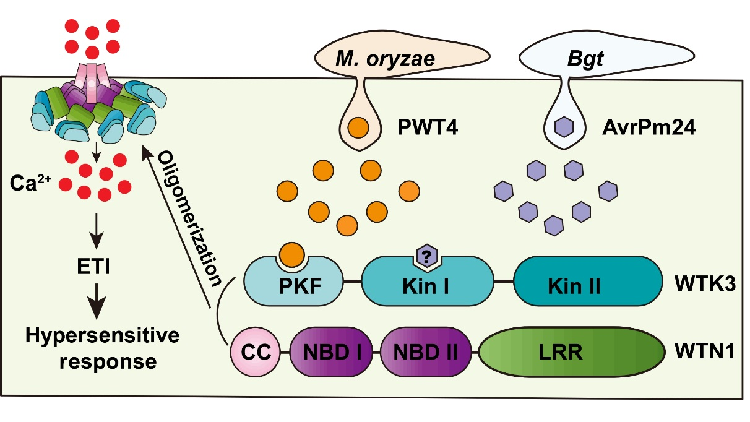
Just recently the plant immunity team led by Professor Liu Zhiyong from the Institute of Genetics and Developmental Biology (IGDB), Chinese Academy of Sciences, together with collaborators from Nanjing Normal University, Yazhouwan National Laboratory, and Xianghu Laboratory, unveiled an unique immune system by which tandem kinases combat pathogen invasion: an atypical NLR protein, WTN1 (Wheat Tandem NBD 1), partners with the tandem kinase WTK3 to discover pathogen effectors and start immune responses, consequently conferring resistance to several fungal illness in wheat.
This research significantly advances the understanding of tandem kinase functionality, establishes a new paradigm for tandem kinase-NLR cooperation in illness resistance, addresses a vital space in the immune regulatory paths of tandem kinases, and provides a strong theoretical and practical structure for the precise engineering of crop varieties with broad-spectrum and multi-pathogen resistance.
The work was published on Friday in Science under the title A wheat tandem kinase and NLR pair confers resistance to several fungal pathogens.
Tandem kinase proteins (TKPs) represent a just recently found class of illness resistance proteins in wheat and barley.
Identified by 2 or more tandemly organized kinase domains, these proteins provide resistance to a variety of fungal pathogens, including stripe rust, leaf rust, stem rust, powdery mildew, wheat blast, and smut, making them highly important for breeding applications.
Formerly, the plant resistance research group led by Liu at IGDB successfully cloned the broad-spectrum grainy mildew resistance genes Pm24 (WTK3, Nature Communications, 2020) and Pm36 (WTK7-TM, Nature Communications, 2024), which encode unique tandem kinases derived from Chinese wheat landraces and wild emmer wheat, respectively.
Despite these advances, crucial scientific concerns stay unanswered concerning these unique resistance proteins, such as the systems by which tandem kinases recognize pathogen effectors (Avr), the functional roles of their distinct kinase domains in crop resistance, and the particular immune pathways through which tandem kinases activate disease resistance responses.Through screening EMS-induced susceptible mutants of the powdery mildew resistance gene Pm24 (WTK3), the research team recognized WTN1, a pivotal element of the WTK3-mediated disease resistance path.
WTN1, an irregular NLR protein, is firmly connected to WTK3.
Hereditary analyses showed that WTN1 is essential for WTK3-mediated immunity against wheat grainy mildew, with the WTK3-WTN1 set triggering immune actions via a sensor-executor cooperative model.
Significantly, WTK3 not just gives resistance to wheat powdery mildew however also recognizes the wheat blast effector PWT4, activating immune actions and displaying possible resistance to wheat blast.
By employing a multidisciplinary approach &-- consisting of plant immunology, biochemical assays, electrophysiological experiments, and evolutionary analysis &-- the group uncovered a closely coordinated relationship between WTK3 and WTN1, which makes it possible for wheat to combat pathogen intrusion.
Specifically, WTK3 features two crucial functional modules: the first module, making up the pseudo-kinase fragment (PKF) and the first kinase domain (Kinase I), is accountable for acknowledging pathogen effectors, while the second kinase domain (Kinase II) engages with the NLR protein WTN1, forming a robust defense team.
Upon finding pathogens intrusion, the WTK3-WTN1 complex is quickly triggered, forming an ion channel that assists in calcium ion (Ca²⁺& sup2; ⁺)increase, thereby inducing hypersensitive responses and configured cell death.Importantly, prior research study has developed that Pm24 (WTK3) is a special genetic resource originated from Chinese wheat landraces.
Through years of backcrossing and marker-assisted breeding, the team successfully introduced Pm24 into multiple high-yield wheat varieties, and the newly developed disease-resistant germplasms have been easily dispersed to domestic organizations for breeding applications.
These findings are anticipated to address the shortage of broad-spectrum grainy mildew resistance genes in Chinas major wheat-producing regions, establish a prospective hereditary barrier versus wheat blast, and offer essential theoretical and technical support for sustainable agricultural development and industrial upgrading.This work was supported by the National Key R&D Program of China, the Strategic Priority Research Program of the Chinese Academy of Sciences, the National Natural Science Foundation of China, and the Youth Innovation Promotion Association of the Chinese Academy of Sciences.

 5
5
















